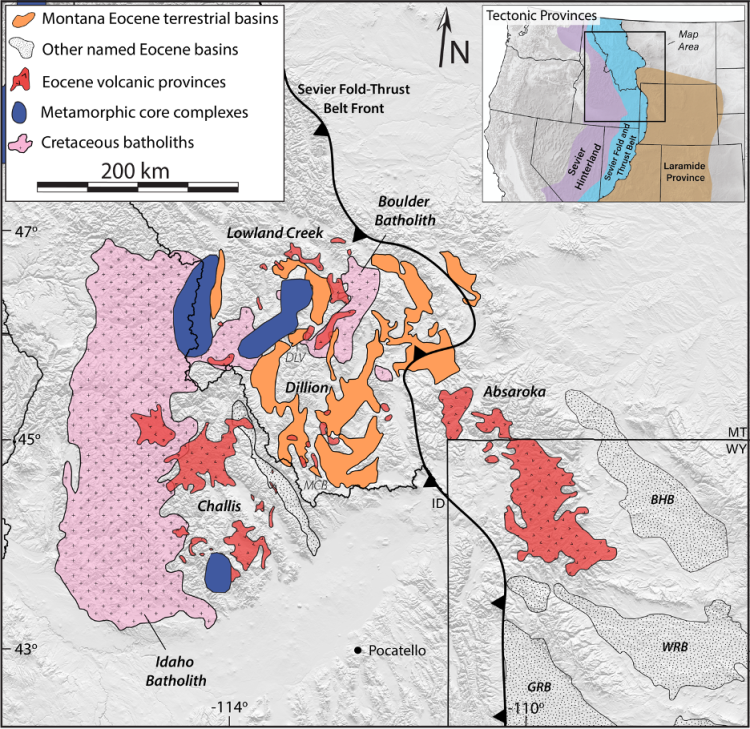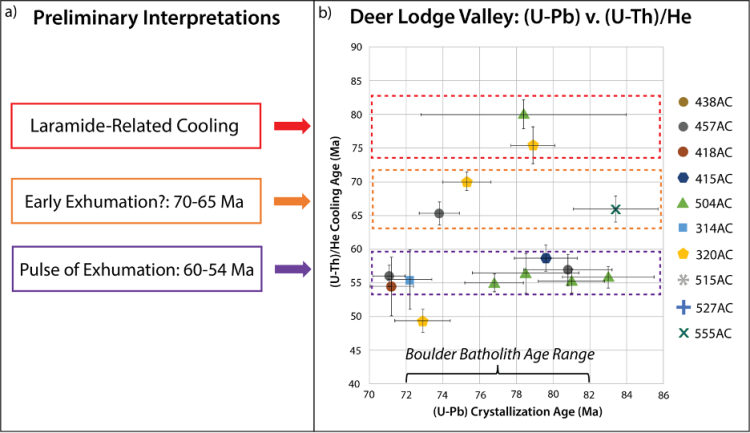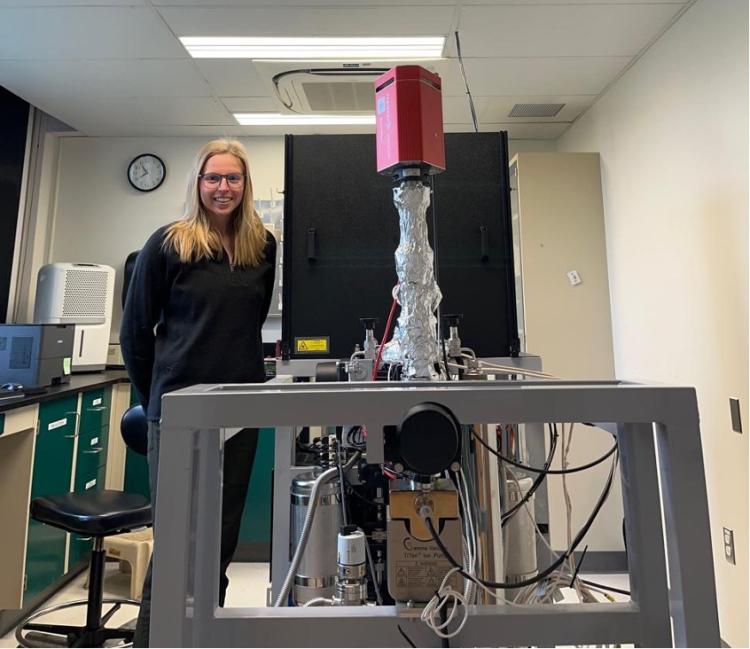Haley Thoresen - Project Profile
2021 AGeS awardee
Lab: UCONN Basin Analysis & Helium Thermochronology Laboratory
Lab Mentors: Julie Fosdick
What scientific question(s) does your research address and what motivates this work?
My project aimed to better understand the extensional history of southwest Montana. Following Sevier and Laramide compressional deformation, there have been multiple overprinting episodes of extension dating as far back as 55 Ma. Across Idaho and Montana, Eocene sedimentary rocks record a period of widespread basin formation and filling linked to metamorphic core complex exhumation (Deer Lodge Valley) and episodic collapse of structural culminations (Muddy Creek Basin) (Fig. 1). The problem is that existing chronometry does not constrain the earliest phase of extension or the relationship between deformation and basin evolution, which are key to understanding the distribution of extensional styles and drivers for MCC formation. Deciphering extensional styles and drivers of metamorphic core complex exhumation are crucial to our understanding of the mechanical processes contributing to collapsing lithosphere, the role that metamorphic core complexes play in the differentiation of crust, and the evolution of orogenic belts through geologic time.

Figure 1: Eocene sedimentary rocks record a period of widespread basin formation and filling linked to metamorphic core complex exhumation (Deer Lodge Valley) and episodic collapse of structural culminations (Muddy Creek Basin).
What chronometric tool did you employ and why?
I utilized detrital zircon (U-Pb)/(U-Th)/He double dating (with AGeS funding supporting He analyses) and single crystal sanidine 40Ar/39Ar dating in both the Muddy Creek Basin and Deer Lodge Valley. Sanidine 40Ar/39Ar dating of interbedded tuffs allowed be to obtain improved depositional age control. Detrital zircon (U-Pb) (U-Th)/He provided both crystallization and cooling ages on targeted age clusters to calculate lag times: an individual grain’s travel time from cooling to deposition. These ages also allowed me to determine provenance trends. Detrital zircon double dating and lag time calculations accompanied by depositional age control allowed me to not only reconstruct paleodrainage pathways through southwest Montana, but place temporal constraints on the timing of initiation of extension in both the Muddy Creek Basin and Deer Lodge Valley.
What were some of the key takeaways of your research?
- Detrital zircon (U-Th)/He cooling ages show a possible earlier pulse of exhumation between 60-54 Ma in the Anaconda metamorphic core complex, which is earlier than previously found in basement thermochronologic studies (Fig. 2).
- This work provided the first detailed stratigraphic and geochronologic study of the Muddy Creek basin, providing temporal constraints on not only deposition (49-35 Ma), which is older than previously thought, but the timing of the initiation of extension (49 Ma), which was not previously constrained.
- There are stark differences in the amount of extension and depositional history between these two extensional basins, pointing to a possible difference in the drivers and mechanisms of extension during the Eocene.

Figure 2: Detrital zircon (U-Th)/He cooling ages show a possible earlier pulse of exhumation between 60-54 Ma in the Anaconda metamorphic core complex, which is earlier than previously found in basement thermochronologic studies.
What new experiences, opportunities, and collaborations did you gain as an AGeS-Grad awardee?
Receiving an AGeS-Grad award allowed me to foster a new collaboration between myself and Dr. Julie Fosdick at the University of Connecticut, which has been extremely beneficial to my project and has helped me grown into a better scientist. I additionally spent two weeks analyzing samples in Dr. Fosdick’s lab, gaining invaluable experience running a mass spectrometer (Fig. 3) and learning the methodology behind detrital zircon (U-Th)/He dating. I have met people through the AGeS grant that I likely would have never met before and will likely collaborate with throughout my career, and for that I am forever grateful.
What is one piece of advice you have for future AGeS-Grad award applicants or awardees?
My advice for future awardees is to start the grant early and contact your lab manager early. Don’t be afraid to ask for help from them, especially when it comes to budget and time management.

Figure 3: Haley Thoresen in the Fosdick lab running a mass spectrometer

